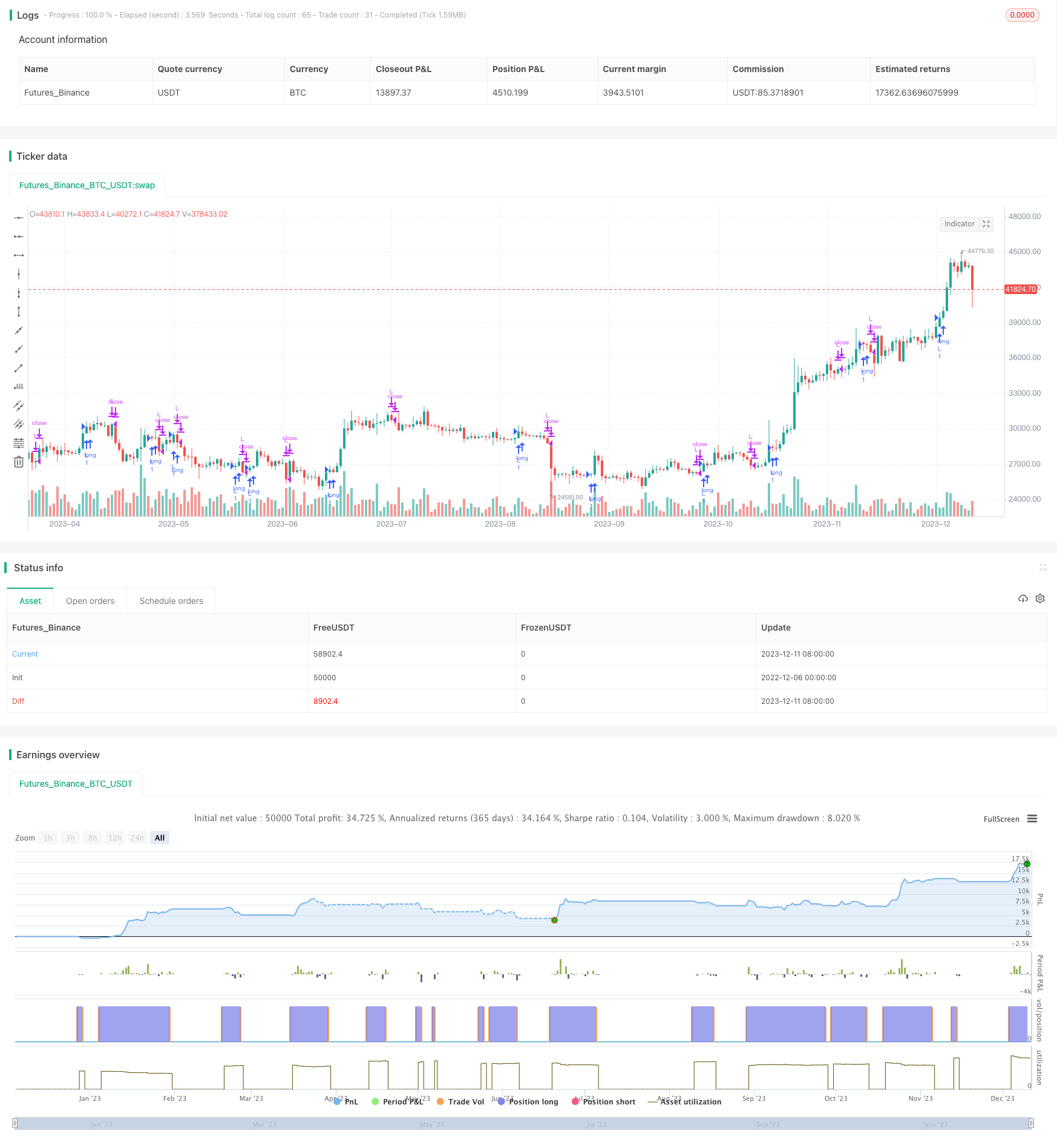
概述
该策略是一个基于MACD指标的复合量化交易策略。它综合使用了MACD,KDJ等多个指标,通过指标之间的组合来产生交易信号。
策略原理
该策略的核心指标是MACD。MACD代表指数移动平均线,是一种趋势跟踪指标。它由一个快速移动平均线(EMA)和一个慢速移动平均线(EMA)组成。快线默认参数为12,慢线默认参数为26。策略会计算两条EMA线之间的差值,即DIF。然后再对DIF求一个9日的EMA,得到DEA指标。当DIF上穿DEA时产生买入信号,下穿时产生卖出信号。
该策略还引入了KDJ指标。KDJ指标包括K值、D值和J值。其中,K值指随机值,D值是K值的移动平均线,J值指确定性值。KDJ指标反映市场的超买超卖状态。当J值大于100时代表超买,小于10时代表超卖。策略会结合KDJ指标,避免在市场转折点发出错误信号。
策略优势
该策略综合运用MACD和KDJ等多个指标,可以有效过滤市场噪音,识别趋势方向。MACD指标可以及时捕捉短期价格变动,KDJ指标可以确认中长期趋势。两者的结合可以平衡追求敏捷和稳定之间的关系。
另外,策略加入了时间选择器,可以自行选择回测的时间范围。这为评估策略表现提供了更大的灵活性。
策略风险及解决方法
当市场长期震荡时,MACD将出现多次误报。这时可以适当调整EMA线的参数,过滤部分噪音。
KDJ指标参数设置不当也会影响结果。可以测试多组参数,选择更稳定的参数组合。
回测时间选择不当,会高估或低估策略收益。应选择有代表性的时间范围进行测试。
优化方向
该策略可以从以下方面进行优化:
增加止损机制。当价格触发止损线时,强制平仓止损。
增加更多指标过滤器。结合RSI、布林带等其他指标,可以提高信号的准确性。
优化指标参数。改变EMA和KDJ参数的组合,寻找最优参数。
利用机器学习技术自动优化。使用神经网络等进行策略参数训练和优化。
总结
该策略是一个典型的以趋势跟踪为主,辅以超买超卖控制的量化策略。它融合多种指标优势,可以有效平衡稳定性和灵敏度。通过持续优化和调整,进一步扩大策略适用场景,从而获得长期稳定收益。
/*backtest
start: 2022-12-06 00:00:00
end: 2023-12-12 00:00:00
period: 1d
basePeriod: 1h
exchanges: [{"eid":"Futures_Binance","currency":"BTC_USDT"}]
*/
//@version=4
strategy(title="New Renaissance", shorttitle="New Renaissance", overlay=true,initial_capital=10000)
source = close
fastlength=input(12, minval=1)
slowlength=input(26,minval=1)
signallength=input(9,minval=1)
// === Defining the MACD oscillator
fastMA=ema(source,fastlength)
slowMA=ema(source,slowlength)
MACD=fastMA-slowMA
signal=sma(MACD,signallength)
delta=MACD-signal
// === Buy and Sell Signals ===
buy=crossover(MACD, signal)
sell=crossunder(MACD, signal)
// === INPUT BACKTEST RANGE ===
fromMonth = input(defval = 1, title = "From Month", type = input.integer, minval = 1, maxval = 12)
fromDay = input(defval = 1, title = "From Day", type = input.integer, minval = 1, maxval = 31)
fromYear = input(defval = 2018, title = "From Year", type = input.integer, minval = 1970)
thruMonth = input(defval = 12, title = "Thru Month", type = input.integer, minval = 1, maxval = 12)
thruDay = input(defval = 31, title = "Thru Day", type = input.integer, minval = 1, maxval = 31)
thruYear = input(defval = 2020, title = "Thru Year", type = input.integer, minval = 1970)
// === INPUT SHOW PLOT ===
showDate = input(defval = true, title = "Show Date Range", type = input.bool)
// === FUNCTION EXAMPLE ===
start = timestamp(fromYear, fromMonth, fromDay, 00, 00) // backtest start window
finish = timestamp(thruYear, thruMonth, thruDay, 23, 59) // backtest finish window
window() => true // create function "within window of time"
// === EXECUTION ===
strategy.entry("L", strategy.long, when = window() and buy) // enter long when "within window of time" AND crossover
strategy.close("L", when = window() and sell) // exit long when "within window of time" AND crossunder